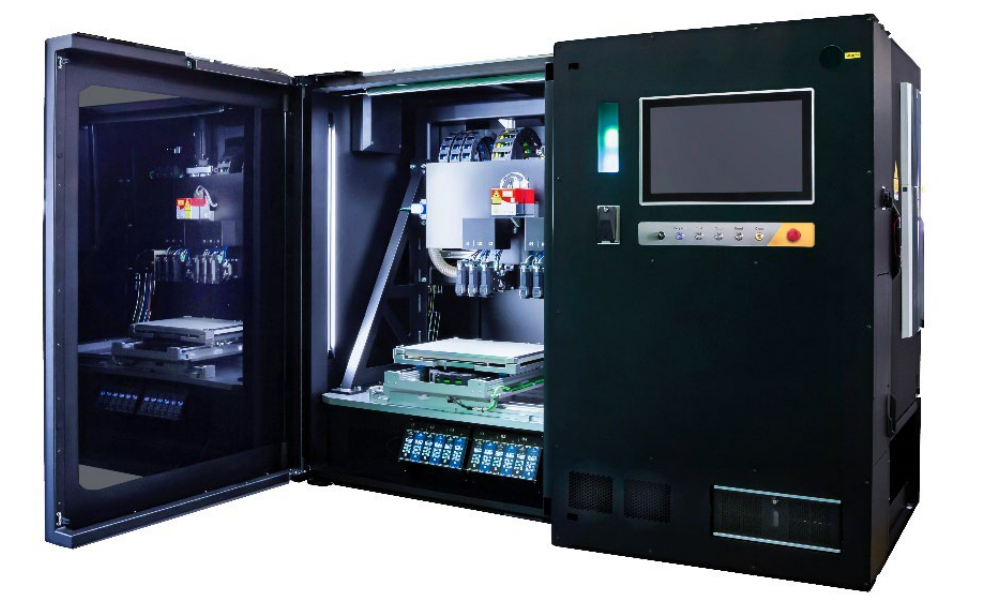Fraunhofer Institute for Ceramic Applied sciences and Methods (IKTS) spin-off AMAREA Expertise has put in an MMJ ProX 3D printing machine on the institute, additional increasing its work in Multi Materials Jetting (MMJ) know-how.
This addition expands the institute’s analysis capabilities in additive and hybrid manufacturing, notably with ceramic supplies, reinforcing its position in growing multi-material printing purposes. For these within the specifics, the system operates with droplet volumes starting from 0.5 to 50.0 nanoliters (nl), droplet diameters from 200 µm to over 1,000 µm, and layer thicknesses between 70 and 300 µm.
“We’re happy that Fraunhofer IKTS is among the many first prospects to make the most of our system for the event of novel merchandise, thereby increasing the marketplace for Multi-Materials purposes,” says Steven Weingarten, developer of MMJ know-how and co-managing companion of AMAREA Expertise.


Precision multi-material printing for advanced parts
The MMJ ProX system comes with a construct quantity of 530 x 300 x 200 mm, making it appropriate for each small and large-scale advanced parts. Not like standard strategies that require in depth effort for tailor-made materials properties, this method allows exact management over hardness, flexibility, conductivity, and chemical resistance.
By combining totally different supplies inside a single print job, producers and researchers can create elements with customized properties, from UV-resistant and structurally sturdy parts to fine-tuned aesthetic and tactile finishes.
One of many key benefits of the MMJ ProX sequence is its modular design, which affords numerous configuration choices based mostly on industrial and scientific wants. The model put in at Fraunhofer IKTS is supplied with six printheads, enabling simultaneous processing of as much as six totally different supplies.
This functionality opens up a variety of purposes throughout aerospace, electronics, mechanical engineering, power, and medical sectors. It additionally presents alternatives in additional specialised fields comparable to additive manufacturing for jewellery and watchmaking.
On the core of MMJ know-how is its skill to deposit particle-filled thermoplastic supplies in droplet kind with excessive precision. Materials is positioned solely the place wanted, making certain environment friendly fusion and layer formation inside fractions of a second.
This methodology not solely reduces post-processing but additionally improves materials utilization. Moreover, monomaterials might be re-melted and reused, whereas the printing materials stays steady for long-term storage, making the method each sensible and sustainable.
Based on the spin-off, the MMJ ProX system is designed for accuracy and effectivity, permitting customers to fine-tune porosity or create totally dense buildings relying on software wants. Speedy cooling ensures instantaneous solidification, contributing to dimensional stability. The machine can also be suitable with a variety of fabric lessons, making it adaptable to totally different manufacturing necessities.


Increasing purposes of multi-material 3D printing
Constructing on its suitability, multi-material 3D printing has been utilized in numerous purposes together with the likes of dental and medical.
For instance, US-based 3D printer OEM 3D Methods launched a multi-material 3D printed denture answer, introducing what it described because the trade’s first jetted, monolithic denture providing. The system makes use of two distinct supplies, NextDent Jet Denture Enamel for rigidity and aesthetics, and NextDent Jet Denture Base for flexibility and affect resistance.
Designed for high-volume manufacturing, the answer combines high-speed jetting know-how with monolithic 3D printing to speed up manufacturing. With this method, the answer permits for improved accuracy, repeatability, and a decrease whole price of operation for dental labs and practitioners.
One other notable contribution got here from Finnish bioprinting agency Brinter introducing what it described because the world’s first multi-material, multi-fluidic bioprinting printhead, increasing potentialities in tissue engineering and regenerative medication. Designed to be used with its personal 3D bioprinters, the system underwent pilot testing with choose analysis establishments and pharmaceutical corporations.
Intensive materials capabilities of the printhead allowed for higher-precision purposes, together with tissue restore and localized illness therapies. With assist for as much as 4,096 materials combos in a single construct, the printhead aimed to eradicate the necessity for a number of instruments when processing granulates, pastes, and liquids.
What 3D printing developments must you be careful for in 2025?
How is the way forward for 3D printing shaping up?
To remain updated with the newest 3D printing information, don’t overlook to subscribe to the 3D Printing Trade e-newsletter or comply with us on Twitter, or like our web page on Fb.
When you’re right here, why not subscribe to our Youtube channel? That includes dialogue, debriefs, video shorts, and webinar replays.
Featured picture exhibits profitable handover of the MMJ ProX 3D printing machine at Fraunhofer IKTS from AMAREA Expertise CEO Steven Weingarten to Lisa Gottlieb, Analysis Affiliate at Fraunhofer IKTS. Photograph by way of AMAREA Expertise.



